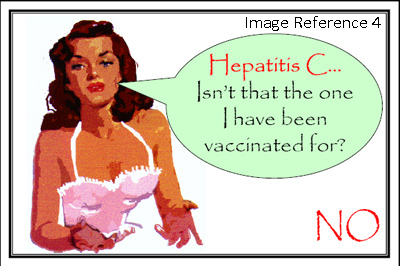Hepatitis C
While this STI has been around for a long time, it was only branded and recognized in 1989 (Health Canada, 2009). Hepatitis C is a liver infection caused by the HCV virus that causes an inflammation of your liver. As the body has a difficult time eliminating this infection from the body, Hepatitis C can often become a chronic disease and can result in liver failure (MedicineNet, 2012). Hep C is found worldwide with an estimated 170 million cases, with 1/4 million cases in Canada (Canadian Liver Foundation, 2012). Of those cases, approximately 21% remain undiagnosed and unaware they carry the infection. These people may be carrying the virus and not experiencing symptoms but they are still infectious (Public Health Agency of Canada, 2012).
How Can I Get Hepatitis C?
This infection is passed through blood to blood contact (Canadian Liver Foundation, 2012) and can be transmitted a number of ways including getting tattooed or pierced with tools used on an infected person that have been improperly sterilized, having sex with an infected person, sharing needles with an infected person, using the razor or toothbrush of an infected person, or being born to a mother with the infection (National Digestive Diseases Information Clearinghouse, 2012).
Hepatitis C cannot be passed by coughing or sneezing, shaking hands with someone carrying the infection, using toilet seats, hugging or kissing, oral sex (unless blood is present), breastfeeding (unless the nipples are cracked and bleeding), or the sharing of drinks, food, or eating utensils (Canadian Liver Foundation, 2012).
Hepatitis C Facts
Prevention
 Sadly, while there is no vaccine for Hepatitis C, it is easy to prevent contracting it with some careful precautions. It includes the usual such as:
Sadly, while there is no vaccine for Hepatitis C, it is easy to prevent contracting it with some careful precautions. It includes the usual such as:
- Practice safe sex
- Ensure proper screenings of all sexual partners
- Avoid sharing personal items like toothbrushes, nail clippers, or razors
- Refrain from sharing drug needles or other drug paraphernalia (straws for snorting, etc)
- Ensure to properly clean all toys used in play
- If cleaning up blood, use a solution that includes 1 part bleach to 10 parts water (PubMed Health, 2012)
Community Connections
Places to find help or support for those who have Hepatitis C
Hep C BC
Youth Co
Regent Park Community
Article References
Canadian Liver Foundation. (2012). Hepatitis C. Retrieved 07 26, 2012, from Canadian Liver Foundation: http://www.liver.ca/liver-disease/types/viral_hepatitis/Hepatitis_C.aspx
Health Canada. (2009, 05 08). Hepatitis C. Retrieved 07 26, 2012, from Health Canada: http://www.hc-sc.gc.ca/hl-vs/iyh-vsv/diseases-maladies/hepc-eng.php
MedicineNet. (2012). Hepatitis C Infection. Retrieved 07 26, 2012, from MedicineNet: http://www.medicinenet.com/hepatitis_c/article.htm
National Digestive Diseases Information Clearinghouse. (2012, 05 10). What I need to know about Hepatitis C. Retrieved 07 26, 2012, from NDDIC: http://digestive.niddk.nih.gov/ddiseases/pubs/hepc_ez/
Public Health Agency of Canada. (2012, 06 11). Hepatitis C. Retrieved 07 26, 2012, from Public Health Agency of Canada: http://www.phac-aspc.gc.ca/hepc/index-eng.php
RedOrbit. (2012, 07 18). Study Shows Nothing Beneficial in treating Hepatitis C With Milk Thistle Extract. Retrieved 07 26, 2012, from RedOrbit: http://www.redorbit.com/news/health/1112658538/study-shows-nothing-beneficial-in-treating-hepatitis-c-with-milk-thistle-extract/
Image References
Someone else's art deserves recognition! The images presented in this article were borrowed from the following places:
Header Image: http://2.bp.blogspot.com/_FJIuiFqWyO4/TCJmafuYr8I/AAAAAAAAACk/F8OwRmBngc4/s1600/HCVvirus.jpg | Retrieved July 26, 2012
Image 4: http://www.hepcnetwork.org/frontpostcarden.png | Retrieved July 26, 2012